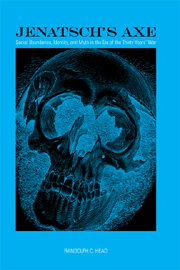Book contents
- Frontmatter
- Contents
- List of Illustrations
- Acknowledgments
- Prologue: Murder (Victim) in the Cathedral
- Introduction
- Chapter 1 A Brief Life of George Jenatsch
- Chapter 2 “Georgius Jenatius, Engadino-Rhetus”: Mapping Identity among Region, Nation, and Language
- Chapter 3 From Religious Zealot to Convert
- Chapter 4 “Something That Every Goatherd Can Do”: Pastor, Soldier, and Noble
- Chapter 5 Hidden Boundaries?: Behind Conventional Views of Jenatsch
- Chapter 6 Jenatsch after 1639: Storytelling in Biography and Myth
- Epilogue: The Past, the Present, and Magic Bells
- Notes
- Bibliography
- Index
Chapter 6 - Jenatsch after 1639: Storytelling in Biography and Myth
Published online by Cambridge University Press: 05 February 2013
- Frontmatter
- Contents
- List of Illustrations
- Acknowledgments
- Prologue: Murder (Victim) in the Cathedral
- Introduction
- Chapter 1 A Brief Life of George Jenatsch
- Chapter 2 “Georgius Jenatius, Engadino-Rhetus”: Mapping Identity among Region, Nation, and Language
- Chapter 3 From Religious Zealot to Convert
- Chapter 4 “Something That Every Goatherd Can Do”: Pastor, Soldier, and Noble
- Chapter 5 Hidden Boundaries?: Behind Conventional Views of Jenatsch
- Chapter 6 Jenatsch after 1639: Storytelling in Biography and Myth
- Epilogue: The Past, the Present, and Magic Bells
- Notes
- Bibliography
- Index
Summary
A study of the historical Jenatsch reveals that the novel's beauty … must be attributed not to the historical material, but to the author. It is what the author made out of the material that turned Meyer's Jürg Jenatsch into the work of art that we now possess.
—Julius Sahr, C. Ferd. Meyer: Jürg Jenatsch, 1904A figure as complex and ambiguous as George Jenatsch was bound to leave strong impressions on the men and women who knew him. His accomplishments during his period of genuine prominence in the 1630s, moreover, made him highly visible within the narrow confines of the Three Leagues, thus ensuring that he would indeed be remembered, though not always in a positive way. It is to the richness and ambiguity of memories about him, and thus in a sense to Jenatsch's career after his death in 1639, that this chapter turns. The man himself crossed cultural and social boundaries repeatedly while alive; once dead, the memory of him soon challenged the boundary between history and myth, as diversely placed authors sought to bring him back to life in their works.
Two seemingly contradictory conclusions become visible when one looks at the literature about Jenatsch, from the earliest mentions in chronicles written shortly after he died, through a famous nineteenth-century novel and two major scholarly biographies, right up to Daniel Schmid's quirky 1987 movie.
- Type
- Chapter
- Information
- Jenatsch's AxeSocial Boundaries, Identity, and Myth in the Era of the Thirty Years' War, pp. 111 - 132Publisher: Boydell & BrewerPrint publication year: 2008



